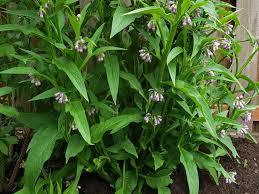Growing Comfrey from Seed: How to Cultivate This Soil-Enhancing Herb
Comfrey (Symphytum officinale), also known as true comfrey, is a hardy perennial herb prized for its ability to enrich soil and support a healthy garden ecosystem.
With its deep roots, nutrient-rich leaves, and clusters of purple flowers, comfrey is both beautiful and practical. Learning how to grow comfrey from seed is a rewarding way to add this soil-boosting plant to your organic garden.

What Is Comfrey?
Comfrey is native to Europe and widely grown across North America. A mature comfrey plant can grow up to three feet tall, producing broad, fuzzy green leaves and bell-shaped purple flowers that attract bees and other pollinators. Its deep roots reach several feet underground, pulling up nutrients that improve the surrounding soil.
There are a few main types: common comfrey, true comfrey, and Russian comfrey (Bocking 14). True comfrey can produce viable seeds, while the sterile Bocking 14 variety is usually propagated from root cuttings.
How to Grow Comfrey from Seed
1. Stratify the Seeds
Comfrey seeds need a short cold period before germination. Place the comfrey seeds in a moist paper towel or peat moss, seal them in a plastic bag, and refrigerate for 4–6 weeks. This mimics winter conditions and helps them sprout successfully.
2. Start Indoors
After stratification, sow seeds about ¼ inch deep in trays filled with well-draining soil. Keep the soil slightly moist and place the trays in full sun to partial shade. Germination can take 20–30 days.
3. Transplant Outdoors
When seedlings develop a few sets of true leaves, transplant them into the garden once the danger of frost has passed. Choose a sunny or lightly shaded area with rich organic matter and good drainage. Space plants about 2–3 feet apart to allow for their spreading habit.
4. Care and Maintenance
Water regularly during the first year to establish strong deep roots. Once mature, comfrey becomes drought tolerant and low-maintenance. During the growing season, apply compost or an organic liquid fertilizer to encourage leafy growth.
5. Harvesting Leaves
You can begin harvesting comfrey leaves once the plant is well established. Cut them about two inches above the base several times per season. Use the leaves as mulch, add them to compost, or make compost tea—a nutrient-rich liquid fertilizer for your garden.

Why Grow Comfrey?
Comfrey is a gardener’s ally for improving soil health. Its green leaves are loaded with nutrients, and the plant’s deep roots help break up compacted soil. Comfrey’s dense growth also suppresses weeds naturally. Varieties like Russian comfrey (Bocking 14) are especially valued for their productivity and low maintenance.
If you’d like to start growing comfrey, explore True Comfrey Seeds and other herb seeds from Grow Organic. Don’t forget to check your growing zone and stock up on fertilizer and growing supplies.
In Summary
Growing comfrey from seed is simple once you understand its needs. This true comfrey plant rewards you with lush green leaves, striking purple flowers, and long-term soil benefits.
Whether used for mulch, compost tea, or liquid fertilizer, comfrey is an easy, sustainable way to keep your garden thriving year after year.

